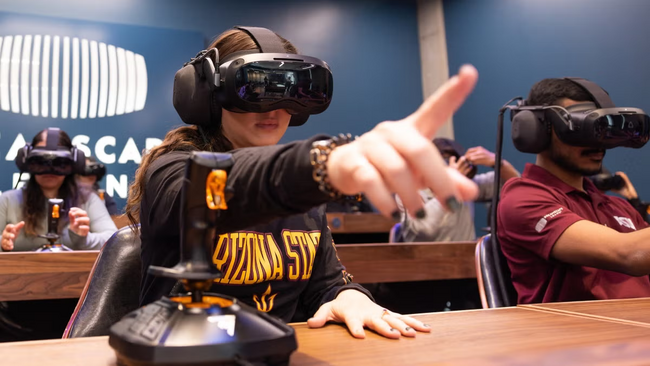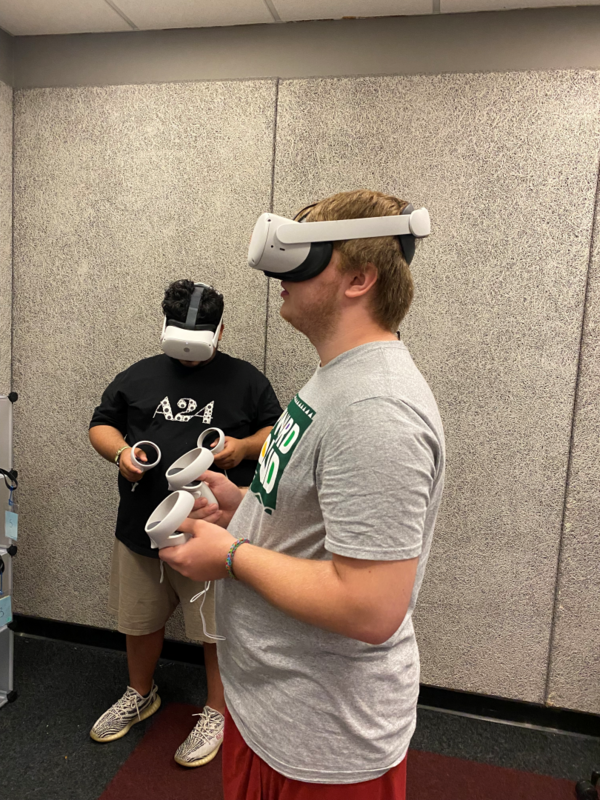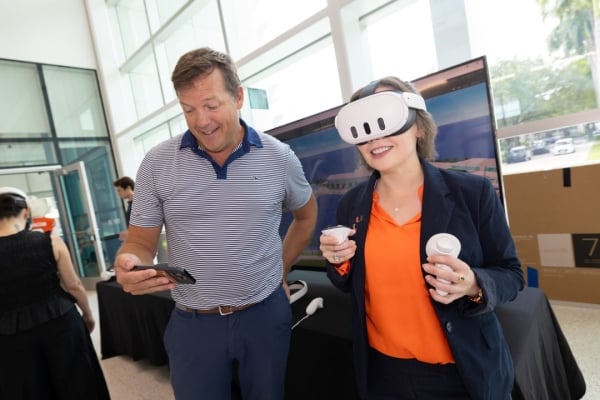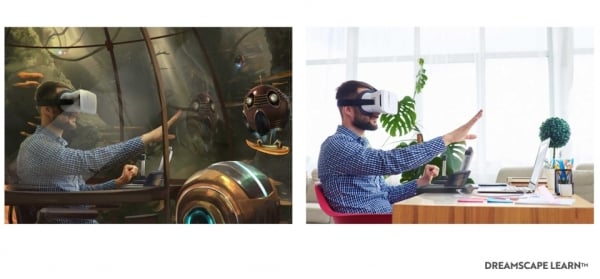You have /5 articles left.
Sign up for a free account or log in.

Students take part in the Dreamscape Learn VR experience at Arizona State University.
Arizona State University
As virtual reality technology continues to develop, more colleges and universities are integrating it into the student experience inside and outside of the classroom.
A recent survey of chief technology officers by Inside Higher Ed and Hanover Research found that 14 percent of respondents said their institutions had made meaningful investments in virtual reality and immersive learning, up seven percentage points from the previous year. Only 32 percent of respondents indicated that virtual reality or immersive learning technology was not in the institution’s short-term plans.
Augmented and virtual reality have been touted as ways to give students fantastical experiences, such as a fictional biology lab for imaginary creatures, or to simulate real-world challenges with lower stakes, such as clinical simulations with patients.
A 2022 survey of college administrators found that 89 percent see allowing students to test real-world lessons in low-risk situations as a benefit of immersive learning, and 78 percent see it as an asset for visualizing difficult or abstract concepts. Over half of respondents also said they expect the use of immersive technologies to become widespread in teaching and campus experiences in the next five years.
Prior research points to the value of virtual reality as a teaching tool, as well. One study from the University of Kansas found that students say they’re more engaged with augmented reality lessons than video lessons, but students who worked with the AR model learned less than their peers who watched video content, according to pre- and post-assessments.
Inside Higher Ed compiled seven examples of colleges and universities that are utilizing AI in student learning and engagement to promote their overall success.
- Austin Peay State University—Mock Trials
Starting this fall, the Department of Criminal Justice at the Tennessee-based university will integrate VR headsets into the curriculum to allow students to conduct virtual mock trials. The university first integrated the technology into the course Intro to Criminal Justice, allowing students to have a 360-degree view of a courtroom.
The department owns 30 Meta Quest 3 VR headsets to enable students to engage in 360-degree movement with video footage.
In the future, Professor David Kim also sees applications for his policing course; the technology could help students engage with police body cameras or simulate a ride-along with a police officer, according to a university press release. Similarly, in the investigations course, students could use VR to evaluate a crime scene.
The department is also seeking partnerships with criminal justice groups, such as the Montgomery County Jail, to create virtual footage for students to engage with local facilities.
- Indiana University, Indianapolis—Public Speaking

Students can use the headsets in the Speaker’s Lab or on their own with the library checkout system.
IU Indianapolis students don’t have to worry about stumbling over their words during their class presentation: All the attendees are artificial intelligence.
The speech lab on campus owns Meta Quest II VR headsets, which students can check out or utilize in the lab to engage in a VR simulation of public speaking forums, including a conference room, classroom, press conference, interview or TED Talk. The software, VirtualSpeech, provides students with feedback on their oral communication and allows learners to practice in a safe environment. The university hopes to target students in general education public speaking classes first but eventually plans to open the VR tools up to whoever wants to use them.
- Loyola Marymount University—Art Therapy Education
Students in a marital and family art therapy course at LMU can explore a desert oasis, magical fire or intimate campfire setting using Victory XR virtual reality technology. The simulations are designed to help students create their own interesting environments for clinical settings, with the goal of putting clients at ease and making therapy more accessible. Some students have also completed a course on psychological testing and assessment, in which they were able to create artwork in virtual environments. The classroom experience was made possible through a grant from the university and a partnership with the Office of Online Learning.
- West Virginia University—Supply Chain Management
In 2023, WVU created the Wehrle Global Supply Chain Lab, which provides students with hands-on experience in supply chain management through VR tech.
Some of the augmented experiences include visiting a pier, touring a farm, walking through a warehouse or engaging in manufacturing plants.
In addition to simulated experiences, students can engage with real-life experts, lecturers and mentors within the lab, creating a professional network hub for workshops, seminars and employer connections.
- University of Miami—Campus Exploration

Tom Merrick demonstrates the UMVerse to a staff member. The software was developed by students, overseen by faculty members.
University of Miami
New students at the University of Miami can see a different side of the institution using virtual reality, exploring the campus’s digital twin. The UMVerse is the university’s latest XR (extended reality) development, a replica of the Coral Gables campus that includes side quests such as a glassblowing class, a museum visit and a tour of the football stadium.
Students enrolled in First-Year Directions, Miami’s first-year seminar course, can complete a course assignment to explore the campus community by engaging with the UMVerse.
Campus leaders hope the virtual experiences will encourage students to engage in real-world ones, building their comfort level to step into unfamiliar spaces. In addition, the assignment can increase students’ confidence using new technologies such as VR headsets.
- University of Pittsburgh—Pharmacy Education
Pharmaceutical students in the Pharmacotherapy of Cardiovascular Disease course at Pitt don’t have to look hard to find models of the human heart; they can log on to a simulation and engage directly with a digital version of the organ.
The School of Pharmacy partnered with the Pitt Health Sciences Information Technology team and the Peter M. Winter Institute for Simulation Education and Research to transform a lecture-based course into a hands-on learning experience that allows students to interact with arteries, examine cardiac anatomy and monitor medication’s impact on the heart.
Campus leaders are hoping to build a new simulation for physicians, military personnel and emergency medical responders for clinical practice experience.
- Arizona State University—Biology Labs
ASU has been a leader in VR integration in the classroom, first launching the Dreamscape Learn virtual reality biology experiences in 2022, which has since expanded into three introductory biology courses. The university first implemented VR into its STEM courses to close equity gaps in who was completing introductory biology courses.

“I’ve been blown away by students’ reactions,” said Annie Hale, executive director of the Action Lab at Arizona State University.
Within Dreamscape Learn, students experience 15-minute virtual reality scenarios in an intergalactic wildlife sanctuary, encountering fictitious situations that require scientific thinking but don’t have answers that can be found online, ensuring students meet learning outcomes.
Initial outcomes indicate students who engaged with the digital labs earned higher grades in their introductory course and in subsequent courses and were more likely to remain in the school of life sciences.
This article has been updated to correct the location of Austin Peay State University.




